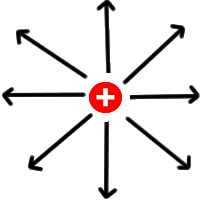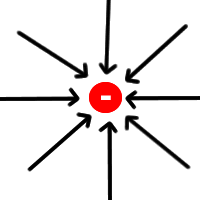Electric Fields

Figure 1. Diagram of a positively-charged particle showing the lines of force created by the electric field.

Figure 2. Diagram of a negatively-charged particle showing the lines of force created by the electric field.
Electric Fields | |
| All matter contains electrons and protons. Electrons have a negative charge, while protons have a positive charge. A charged particle produces an electric field in all directions. This field produces a force that is either directed away or toward the original particle (Figures 1 and 2). This force attracts oppositely charged particles and repels particles with the same charge. If the particle moves, such as electrons in an antenna, the associated electric field moves with it. A difference in electric field strength between two locations is called a voltage. So when we apply a voltage across two ends of a wire the electrons in the wire move toward the positive voltage and away from the negative voltage. | |
|
|
|
Magnetic Fields | |
| If a charged particles moves, it creates a magnetic field. Unlike the electric field, the force lines are directed at right angles to the direction of motion (Figure 3). So if electrons are moving in a wire, there has to be a magnetic field encircling the length of the wire, the direction of the magnetic force depending on the direction of the electron movement. Magnetic and electric fields interact such that a changing magnetic field creates an electric field and a changing electric field creates a magnetic field. The magnetic field shown in Figure 3 is created by the moving electric field associated with the charged particle. Conversely, if a magnetic field moves, an electric field is generated. Moving a magnet past a wire will create a voltage that moves the electrons in the wire. |
|
|
|
Continue to next page of this module